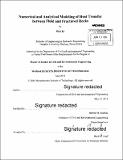| dc.contributor.advisor | Herbert H. Einstein. | en_US |
| dc.contributor.author | Li, Wei, Ph.D. Massachusetts Institute of Technology. Department of Civil and Environmental Engineering. | en_US |
| dc.contributor.other | Massachusetts Institute of Technology. Department of Civil and Environmental Engineering. | en_US |
| dc.date.accessioned | 2014-09-19T21:37:18Z | |
| dc.date.available | 2014-09-19T21:37:18Z | |
| dc.date.copyright | 2014 | en_US |
| dc.date.issued | 2014 | en_US |
| dc.identifier.uri | http://hdl.handle.net/1721.1/90059 | |
| dc.description | Thesis: S.M., Massachusetts Institute of Technology, Department of Civil and Environmental Engineering, 2014. | en_US |
| dc.description | Cataloged from PDF version of thesis. | en_US |
| dc.description | Includes bibliographical references (pages 111-114). | en_US |
| dc.description.abstract | Modeling of heat transfer between fluid and fractured rocks is of particular importance for energy extraction analysis in EGS, and therefore represents a critical component of EGS design and performance evaluation. In conventional fracture dominated geothermal systems with reinjection, this modeling process is also helpful for understanding how the thermal front migrates and for optimizing of reservoir management strategies. Both numerical and analytical approaches are used to help us get a better understanding of the heat transfer process between the fluid and the fractured rocks in a geothermal reservoir. In the numerical approach, a stochastic discrete fracture network model, GEOFRAC, is used to generate a fracture network. GEOFRAC-FLOW, is used to calculate the flow path in the fracture network and flow rate in each fracture. On the basis of the two, a heat transfer model, GEOFRAC-THERMAL, is developed. Parametric studies with the three models are conducted to analyze the sensitivity of the parameters. A case study with the three models on the Fenton Hill project is conducted to demonstrate the capability of the three models in modeling the heat and mass transfer in the geothermal reservoir. In the analytical approach, a conceptual geothermal reservoir model is introduced. The heat transfer process in the fluid and the fractured rock is formulated based on energy conservation. With the assumption of uniform rock temperature, the 0-D solution is obtained. Parametric studies and case study on the Fenton Hill project are conducted with the 0-D solution. With the assumption of heat conduction happening only in the transverse direction of the rock, the 1-D solution is obtained. Parametric studies are conducted with the 1 -D solution and useful conclusions are obtained. A simply configured heat transfer problem is used to compare the results of the finite element analysis and the 1-D solution. The effect of the simplification in the 1 -D solution is analyzed based on the comparison. | en_US |
| dc.description.statementofresponsibility | by Wei Li. | en_US |
| dc.format.extent | 125 pages | en_US |
| dc.language.iso | eng | en_US |
| dc.publisher | Massachusetts Institute of Technology | en_US |
| dc.rights | M.I.T. theses are protected by copyright. They may be viewed from this source for any purpose, but reproduction or distribution in any format is prohibited without written permission. See provided URL for inquiries about permission. | en_US |
| dc.rights.uri | http://dspace.mit.edu/handle/1721.1/7582 | en_US |
| dc.subject | Civil and Environmental Engineering. | en_US |
| dc.title | Numerical and analytical modeling of heat transfer between fluid and fractured rocks | en_US |
| dc.type | Thesis | en_US |
| dc.description.degree | S.M. | en_US |
| dc.contributor.department | Massachusetts Institute of Technology. Department of Civil and Environmental Engineering | en_US |
| dc.identifier.oclc | 890140971 | en_US |
